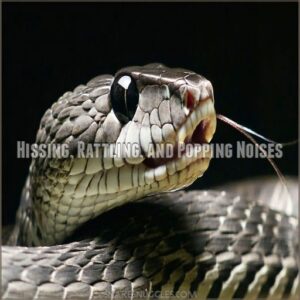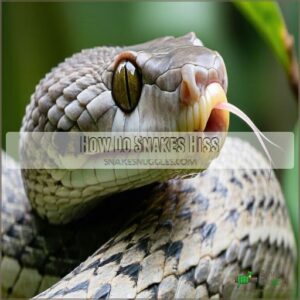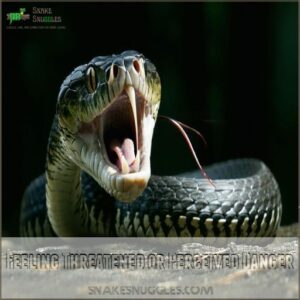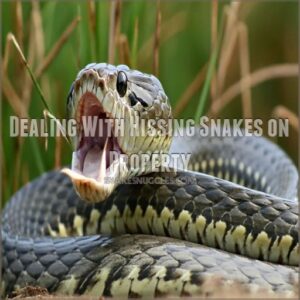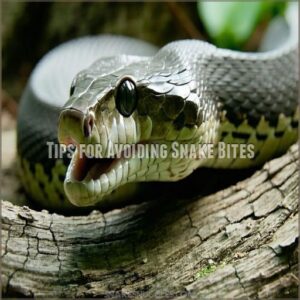This site is supported by our readers. We may earn a commission, at no cost to you, if you purchase through links.
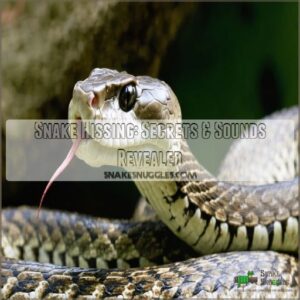
Think of it as nature’s ultimate warning system.
When a snake forces air through its glottis, it creates that distinctive hiss, which can vary from a gentle whisper to an intimidating rasp.
During vulnerable times like shedding or digesting a meal, you’re more likely to hear this defensive sound. The intensity changes based on how threatened they feel, and some species even add their own flair with pops, whistles, or growls.
Understanding these warning signs is your key to mastering safe snake encounters.
Table Of Contents
- Key Takeaways
- Why Do Snakes Hiss
- Snake Hissing Sounds and Types
- How Do Snakes Hiss
- What Triggers Snake Hissing
- Snake Communication and Behavior
- Dealing With Hissing Snakes on Property
- Handling Pet Snakes That Hiss
- Snake Shedding and Stress
- Digestion and Hissing in Snakes
- Tips for Avoiding Snake Bites
- Frequently Asked Questions (FAQs)
- What does it mean when a snake hisses?
- Do harmless snakes hiss?
- Do snakes hiss before striking?
- Which snake makes hissing sound?
- Can baby snakes hiss louder than adult snakes?
- Do snakes hiss underwater or while swimming?
- Which snake species never hiss at all?
- How far can a snakes hiss be heard?
- Does snake hissing change with seasonal temperatures?
- Conclusion
Key Takeaways
- You’ll hear a snake hiss when it feels threatened, stressed, or vulnerable—it’s their primary warning signal telling you to back off.
- You’ll notice increased hissing during specific times like shedding periods (when their vision is impaired) or while they’re digesting food.
- You’ll need to maintain at least 6 feet of distance when you hear a hiss, back away slowly, and ensure the snake has a clear escape route.
- You’ll recognize that both venomous and non-venomous snakes hiss, though the sound intensity varies by species and the level of perceived threat.
Why Do Snakes Hiss
When you hear a snake hiss, it’s like nature’s warning alarm, letting everyone know danger is afoot.
Snakes hiss for all sorts of reasons, from feeling threatened to digesting a good meal.
With a touch of flair that rivals seasoned performers of the reptile world.
Defensive Behavior in Snakes
Imagine this: a snake confronted by a looming threat.
It hisses—a defensive ballet where sound becomes the first line of defense. Hissing signals its discomfort and warns predators to back off.
With variations that might surprise you, from soft and subtle to loud and assertive, snakes use body language and venom delivery as their ultimate countermeasure.
Communication and Warning Signs
When a snake hisses, it’s like your phone buzzing a text alert: “Back off!”
These snake signals aren’t just noise. They’re a mix of defensive postures and body language, ensuring you recognize a warning.
The hiss intensity might hint at how threatened they feel. It’s all about perception—yours and theirs. Catch these snake warning signals to stay safe!
Shedding and Vulnerability
As snakes shed their skin, they become vulnerable to threats, with impaired vision being a real issue.
This limited sight can lead them to feel exposed, much like wearing foggy glasses during a marathon.
Hissing becomes a go-to defense tactic, signaling that they’d rather avoid a showdown. It’s snake behavior at its most primal, blending predator avoidance with stress mitigation strategies.
Stress or Fear Responses
Imagine walking through a garden and suddenly spotting a snake. That hiss? It’s like the snake’s personal siren blaring, "Back off!"
When encountering such situations, having the right snake hissing defense products can be essential.
Stress triggers and fear indicators crank up the hissing intensity. Defensive postures and body language scream, "I’m not in the mood!"
It’s classic snake behavior in danger—nature’s warning system for when a snake feels threatened.
Digesting Food and Energy Conservation
Feeling a tad comfy after a meal? Snakes do too.
As they digest, their metabolic rate affects how often they hiss. It’s like their way of saying, “Don’t bug me, I’m busy!”
Digestion’s energy marathon requires thermoregulation, ensuring energy conservation. Overeating can slow digestion speed, impacting food frequency and snake behavior.
So, give them space—they’re conserving energy! Digestion affects snake behavior. Snakes hiss less when digesting.
Snake Hissing Sounds and Types
You’ll discover that snake "voices" aren’t limited to hissing; some species also rattle, pop, whistle, buzz, growl, or even rasp!
These sounds, varying widely depending on the snake’s type and the situation, are essential for understanding their communication and defense mechanisms.
snake "voices" are diverse.
Hissing, Rattling, and Popping Noises
When snakes hiss, it’s like sending a loud, clear message. But not all snakes sound the same. Some rattle or even pop, creating unique sound variations. Imagine the intensity of a rattlesnake’s buzz, a peculiar symphony of survival.
Here’s more:
- Defensive uses
- Frequency analysis
- Noise intensity
- Species differences
- Snake noises
Whistling, Buzzing, and Growling Sounds
Some snakes can jazz up their defensive repertoire with whistling, buzzing, and growling sounds.
Whistling might remind you of an unexpected breeze, while buzzing and growling are like nature’s musical scores that guarantee predators think twice.
These species-specific sounds—each with its unique sound intensity—highlight the intriguing landscape of snake vocalizations, showcasing how these unusual sounds serve as powerful, instinctual defenses. These species-specific sounds are a key part of their defensive repertoire.
Rasping and Squeaking in Some Species
Beyond the buzzing and growling, snakes surprise us with rare sounds like rasping and squeaking.
Ever hear a snake that squeaks? It’s not a toy; certain species, like the saw-scaled viper, produce rasping sounds by rubbing body parts.
These squeaks aren’t musical notes but defensive squeaks.
Curious how snakes pull off these quirky chirps? It’s all part of their complex communication toolbox!
How Do Snakes Hiss
To hiss, a snake forces air through its glottis, making that famous sound you’d probably prefer not to hear at your feet.
In some species, unique cartilage structures amplify the hiss.
The occasionally misunderstood M. Sphincter muscle produces popping noises, leading you to question if snakes practice percussion in their spare time.
The M. Sphincter Muscle and Popping Noises
Ready for a quirky snake fact?
It turns out the M. Sphincter muscle isn’t just for laughs. This unique muscle creates popping noises, a defensive magic trick in snake life.
It’s like a surprising percussion instrument in nature’s symphony, showing off evolutionary roles across species with fascinating sound variations.
Who knew snake hissing could be so diverse?
Forcing Air Through The Glottis
Imagine this: a snake forces air through the glottis, creating its signature hiss.
This clever trick plays out like a wind instrument, where air pressure varies the hiss intensity.
It’s all about anatomy, with different species producing unique sounds.
So, next time you hear a hiss, remember: it’s a finely-tuned act of survival and communication!
Unique Cartilage Structures in Some Species
Ever wonder why some snakes hiss louder than others?
It’s not just about air pressure; unique cartilage structures play a role. Think of it like a built-in amplifier!
Species like pine snakes boast special cartilage, boosting their hiss intensity.
This structural variation impacts the snake hissing sound, a key part of their communication.
Analyzing these differences reveals fascinating insights into snake vocalization and their evolutionary role in survival. Isn’t nature amazing?
What Triggers Snake Hissing
When a snake hisses, it’s like its way of saying, "Please, leave me alone!"
They’re triggered by various factors such as feeling threatened, handling stress, or even just being startled by a sudden movement.
Feeling Threatened or Perceived Danger
When a snake feels threatened, it doesn’t just sit there—its self-preservation instincts kick in with dramatic flair.
Defensive postures, like hissing, signal a clear message: "Back off!" Snake hissing is a classic predator avoidance tactic, showing threat assessment skills.
Signs a snake is threatened include expanding its body, elevating its head, and preparing for escape routes, showcasing its remarkable survival tactics.
Handling and Environmental Stress
Handling a pet snake can be a balancing act: too much can lead to stress and hissy fits, while too little might leave them bored, as they’re naturally inclined to defend themselves through hissing as a defense mechanism.
Recognize stress signs like rapid hissing or retreating.
Engage them with habitat enrichment, giving them places to explore.
Reducing handling during stress and using safe techniques prevents agitation.
Balance keeps your snake happy!
Shedding and Impaired Vision
Snakes enter a vulnerable phase during shedding as their vision becomes considerably impaired.
Your scaly friend might hiss more frequently during this time – it’s like moving through a room with foggy glasses. This reduced visibility naturally triggers more defensive hissing as they rely heavily on other senses for safety.
The process typically lasts 1-2 weeks, and the snake’s protective blue film (spectacle) causes temporary blindness.
Shedding process
Sudden Movements and Unfamiliarity
Ever wondered why your snake gets jumpy at the slightest movement?
Quick motions trigger a snake’s defensive instincts – it’s like startling you with a sudden loud noise.
You’ll notice more hissing from young or unfamiliar snakes who haven’t learned to distinguish threats from harmless movements.
Even pet snakes can display this behavior until they’re comfortable with their environment and your handling routine.
Snake Communication and Behavior
You’ll be surprised to learn that snakes aren’t the social butterflies of the animal kingdom, as they primarily use hissing and body language to tell others to back off rather than make friends.
When you hear a snake’s defensive hiss, you’re actually witnessing one of nature’s most effective "do not disturb" signs, complete with accompanying displays like body flattening and head inflation.
Defensive Signaling and Warning Calls
Anyone who’s encountered a hissing snake knows it’s nature’s version of a "back off" signal.
When a snake feels threatened, it’ll ramp up its hiss intensity to match the danger level – like a built-in warning system, and various products, such as those found on Snake Warning Gear, can help you prepare for such encounters.
You’ll hear everything from soft, cautionary hisses to loud, intense warnings depending on how close you get.
It’s their primary way of saying "I’d rather not fight, but I’ll if I must.
Non-Vocal Communication and Body Language
Beyond vocal warnings, you’ll notice these fascinating creatures have a whole arsenal of body moves that speak volumes.
When feeling threatened, they’ll curl into an S-shape, raise their heads, and flatten their necks – it’s like their version of making themselves look bigger in the mirror.
Think of it as nature’s own sign language, complete with tail shakes and dramatic head bobs.
Solitary Creatures and Limited Social Interaction
Unlike social butterflies of the animal kingdom, snakes prefer the solo life.
You’ll rarely catch them hanging out in groups, except during mating season when hormones kick in.
While they might share territory with other snakes, they’re not exactly planning snake parties. They’ll communicate through scent markers and occasional hissing, but most interactions are brief – just long enough to mate or establish boundaries.
Dealing With Hissing Snakes on Property
If you’ve got a hissing snake on your property, you’re probably wondering how to handle this nerve-wracking situation without anyone getting hurt.
You’ll be glad to know there are several proven methods to safely manage these unexpected visitors, from using specialized repellents to making your yard less appealing to our scaly neighbors.
Using Snake Repellents and Deterrents
Two proven snake repellents can help keep your property snake-free: Ortho Snake-B-Gon and SEEKBIT Snake Away.
These granular repellents create barriers snakes won’t cross, using natural ingredients like cinnamon and clove oil.
Sprinkle them around your home’s perimeter, focusing on entry points and potential hiding spots.
You’ll need to reapply after rain, but they’re safe for pets and won’t harm beneficial garden wildlife.
Modifying Your Yard to Reduce Attractants
While repellents help, making your yard less snake-friendly is your best defense.
Start by keeping grass short and removing brush piles where rodents nest.
Clear leaves, logs, and debris that create perfect hiding spots, and consider using proven natural repellents instead of ineffective methods like salt.
Seal gaps under sheds, secure trash cans to discourage rats, and consider removing rock gardens or water features.
Think of it like closing down an all-you-can-eat buffet for snakes.
Giving Snakes Space and Avoiding Interaction
Space is your best friend when a snake starts its warning hiss. You’d be surprised how many encounters can be avoided by simply backing away slowly and letting the snake retreat on its own terms.
Here’s what you need to know about keeping safe:
- Stay at least 6 feet away from any hissing snake
- Back away slowly without turning your back
- Keep pets and children behind you
- Give the snake a clear escape route
Remember, most snakes just want their personal bubble respected – kind of like your neighbor who doesn’t want small talk over the fence.
Handling Pet Snakes That Hiss
If your pet snake’s hissing has you feeling like you’re living with a tiny dragon, don’t worry – it’s just their way of saying they need some space or environmental tweaks.
You’ll need to adjust their habitat.
Reduce handling during stressful periods like shedding.
Wear protective gloves when necessary to keep both you and your scaly friend comfortable.
Environmental Adjustments and Reduced Handling
When your pet snake starts hissing more than usual, it’s time to play detective with their environment.
Check if their enclosure provides enough hiding spots, proper temperature zones, and adequate space to move freely.
You’ll want to dial back handling sessions until they’re feeling more secure. Think of it like giving them a mini-vacation – sometimes we all need a break to reset. Dial back handling sessions. Pet snake hissing.
Wearing Protective Gloves and Clothing
Since handling a hissing snake can be nerve-wracking, proper protective gear is your first line of defense. You’ll want to suit up with the right equipment before attempting any interaction with your scaly friend.
- Snake handling gloves made of puncture-resistant kevlar or leather
- Long-sleeved shirts and pants in thick cotton or denim
- Closed-toe boots that cover your ankles
- Snake hooks for safe distance handling
Minimizing Sudden Movements and Stress
Your protective gear’s ready – now let’s focus on smooth moves.
Imagine you’re in a library: slow, deliberate movements keep your snake calm and collected. Quick gestures can trigger defensive hissing, so channel your inner tai chi master.
Create a quiet, low-traffic space for handling sessions, and you’ll notice your snake’s stress levels drop.
Remember: a relaxed keeper means a relaxed snake.
Snake Shedding and Stress
You’ll notice your snake hiss more during shedding because it’s basically wearing sunglasses made of old skin, making it feel extra vulnerable and defensive.
If you’re a snake parent, you’ll want to give your scaly friend some space during this 1-2 week period to prevent stress-induced behaviors like defensive strikes or food refusal.
Vulnerability During Shedding Periods
Snakes become incredibly vulnerable during shedding, like a quarterback playing without protective gear. During this 1-2 week period, they’re less equipped to defend themselves, leading to increased hissing and defensive behaviors.
- Vision becomes severely impaired as old eye caps loosen
- Movement flexibility decreases by up to 40%
- Sensory receptors work at reduced capacity
- Energy levels drop substantially
- Natural camouflage effectiveness decreases by 60%
This natural process leaves them more susceptible to threats, so they’ll often increase their defensive hissing to compensate for these temporary limitations.
Managing Stress and Preventing Biting
During shedding, managing a snake’s stress levels becomes a top priority. Keep handling to a minimum and create a calm environment by dimming lights and reducing noise.
If a snake is exhibiting snake stress symptoms, such as refusal to eat, regurgitating meals, or frequent striking, it’s vital to address the issue promptly.
If you must handle your snake, use slow, deliberate movements and watch for warning signs like coiling or rapid tongue flicks.
A stressed snake is more likely to bite, so it’s best to let them complete their shed undisturbed.
Regulating Temperature and Energy Conservation
Temperature regulation and hissing go hand in hand for these cold-blooded creatures.
When you’re watching your snake hiss during rest periods, they’re actually being smart energy managers.
By minimizing movement and using short, controlled hisses, they’re keeping their body temperature stable while conserving precious energy.
It’s like they’ve mastered their own version of energy-efficient climate control – pretty clever, right?
Digestion and Hissing in Snakes
You’ll notice your snake friend hisses more during mealtime, as they’re protecting their hard-earned meal from any potential disturbances.
If you interrupt their digestion process, you might trigger not just defensive hissing but also cause them to regurgitate their food, which isn’t fun for anyone involved.
Warning Potential Threats and Disturbances
When you’re near a snake that’s digesting its meal, you might hear a menacing hiss – it’s telling you to back off. Think of it as their "Do Not Disturb" sign. While they’re processing food, they’re extra protective of their space.
Here’s what triggers their warning hiss during digestion:
- Approaching too closely
- Sudden movements in their territory
- Unfamiliar sounds nearby
- Changes in their environment’s lighting
Stress Responses and Food Regurgitation
Stress can turn your snake’s peaceful digestion into a real drama.
If you handle or disturb your snake while it’s processing a meal, you’ll likely hear defensive hissing followed by regurgitation, which could be a sign of underlying issues such as poor husbandry practices.
Think of it as your snake’s version of "leave me alone, I’m eating!"
It’s not just being grumpy – the stress actually disrupts their digestive process, forcing them to abandon their meal.
Tips for Avoiding Snake Bites
You’ll want to pay close attention to a snake’s warning signs, like hissing and body posturing.
These natural defense mechanisms are your best clues for staying safe.
Whether you’re hiking through snake territory or stumbling upon one in your backyard, understanding these signals can mean the difference between a peaceful encounter and an emergency room visit.
Recognizing Defensive Behavior and Body Language
During encounters with snakes, their body language speaks volumes about their state of mind. Like a skilled poker player, these reptiles telegraph their next move through distinct warning signals.
Recognizing these signals is essential for snake handling safety.
Here’s what to watch for:
- Head flattening and neck spreading (especially in cobras)
- Rapid tongue flicking and body coiling
- S-shaped posture with raised head
- Tail vibrating against ground or leaves
These defensive displays aren’t just for show – they’re your cue to back off.
Keeping a Safe Distance and Avoiding Interaction
Since snakes prefer flight over fight, giving them plenty of space is your best defense against a bite.
Here’s what to remember when you spot a snake in different situations:
| Location | Safe Distance | Action |
|---|---|---|
| Trail | 6+ feet | Step back slowly |
| Yard | 15+ feet | Call removal service |
| Garden | 10+ feet | Clear path for escape |
Remember: a snake’s hiss isn’t a challenge – it’s asking for space.
Wearing Protective Clothing and Gear
For maximum protection when handling hissing snakes, you’ll want thick leather gloves reaching past your wrists.
snake-proof boots that cover your ankles, and safety eyewear to protect against strikes.
Don’t forget loose-fitting pants made from heavy cotton or denim – they’re harder for fangs to penetrate.
A long-sleeved shirt completes your snake-handling armor, giving you confidence without compromising mobility.
Frequently Asked Questions (FAQs)
What does it mean when a snake hisses?
When a snake hisses at you, it’s sending a clear warning signal that it feels threatened and needs space.
Think of it as their way of saying "back off" before they’re forced to defend themselves.
Do harmless snakes hiss?
Yes, harmless snakes do hiss!
It’s a universal defense mechanism that both venomous and non-venomous snakes use.
You’ll hear corn snakes, pine snakes, and ball pythons making this sound when they’re nervous.
Do snakes hiss before striking?
Imagine your neighbor’s pet cobra raising its head in defense – that’s typical.
Most snakes will hiss as a warning before striking, but not always.
It’s their way of saying "back off" before taking action.
Which snake makes hissing sound?
Most snakes can hiss.
Pine snakes, king cobras, and rattlesnakes are known for their distinctive sounds.
You’ll also hear impressive hissing from corn snakes, ball pythons, and Russell’s vipers in defensive situations.
Can baby snakes hiss louder than adult snakes?
Baby snakes, though smaller in size, can’t hiss as loudly as adult snakes.
Their glottis and respiratory system aren’t fully developed, resulting in softer, higher-pitched hisses compared to their mature counterparts.
Do snakes hiss underwater or while swimming?
Snakes can’t hiss while swimming.
They need air to force through their glottis.
You’ll only hear them hiss when their heads are above water. They need to breathe air to make sounds.
Which snake species never hiss at all?
All snake species possess the ability to hiss, though they mightn’t always use it.
Some snakes prefer other defensive tactics.
They’re physically capable of producing hissing sounds when needed.
How far can a snakes hiss be heard?
Quick as lightning, a snake’s hiss can travel up to 20 feet in ideal conditions.
You’ll hear large species like pine snakes and king cobras more clearly, while smaller snakes produce softer, shorter-range hisses.
Does snake hissing change with seasonal temperatures?
Snake activity, including hissing, changes with temperature.
You’ll notice more aggressive hissing during warm seasons when snakes are active,
while they’re less vocal in colder months when their metabolism slows down.
Conclusion
Like a warning bell in nature’s symphony, snake hissing serves as your guide to safer interactions with these remarkable creatures.
Whether you’re a snake owner or encounter them in the wild, understanding their hissing patterns helps you respond appropriately and avoid dangerous situations.
By respecting these warning signals and maintaining a safe distance, you’ll create a more harmonious relationship with snakes. Remember, a hissing snake isn’t trying to frighten you – it’s simply asking for space and respect. Understanding snake hissing is key to safer interactions.


